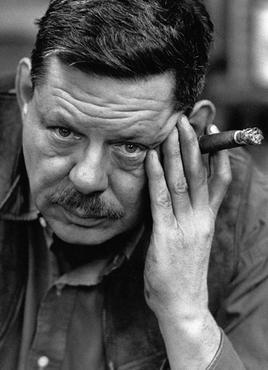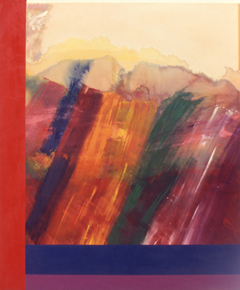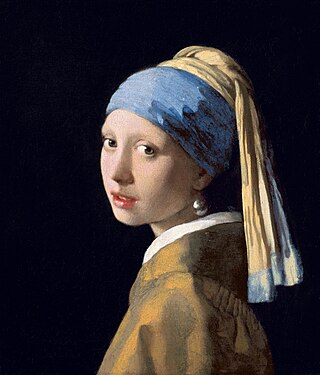Abstract expressionism in the United States emerged as a distinct art movement in the immediate aftermath of World War II and gained mainstream acceptance in the 1950s, a shift from the American social realism of the 1930s influenced by the Great Depression and Mexican muralists. The term was first applied to American art in 1946 by the art critic Robert Coates. Key figures in the New York School, which was the center of this movement, included such artists as Arshile Gorky, Jackson Pollock, Franz Kline, Mark Rothko, Norman Lewis, Willem de Kooning, Adolph Gottlieb, Clyfford Still, Robert Motherwell and Theodoros Stamos among others.

Frank Philip Stella was an American painter, sculptor, and printmaker, noted for his work in the areas of minimalism and post-painterly abstraction. He lived and worked in New York City for much of his career before moving his studio to Rock Tavern, New York. Stella's work catalyzed the minimalist movement in the late 1950s. He moved to New York City in the late 1950s, where he created works which emphasized the picture-as-object. These were influenced by the abstract expressionist work of artists like Franz Kline and Jackson Pollock. He developed a reductionist approach to his art, saying he wanted to demonstrate that for him, every painting is "a flat surface with paint on it—nothing more", and disavowed conceptions of art as a means of expressing emotion. He won notice in the New York art world in 1959 when his four black pinstripe paintings were shown at the Museum of Modern Art. Stella was a recipient of the National Medal of Arts in 2009 and the Lifetime Achievement Award in Contemporary Sculpture by the International Sculpture Center in 2011.

Monochromatic painting has played a significant role in modern and contemporary Western visual art, originating with the early 20th-century European avant-gardes. Artists have explored the non-representational potential of a single color, investigating shifts in value, diversity of texture, and formal nuances as a means of emotional expression, visual investigation into the inherent properties of painting, as well as a starting point for conceptual works. Ranging from geometric abstraction in a variety of mediums to non-representational gestural painting, monochromatic works continue to be an important influence in contemporary art.

Color field painting is a style of abstract painting that emerged in New York City during the 1940s and 1950s. It was inspired by European modernism and closely related to abstract expressionism, while many of its notable early proponents were among the pioneering abstract expressionists. Color field is characterized primarily by large fields of flat, solid color spread across or stained into the canvas creating areas of unbroken surface and a flat picture plane. The movement places less emphasis on gesture, brushstrokes and action in favor of an overall consistency of form and process. In color field painting "color is freed from objective context and becomes the subject in itself."

Roland David Smith was an influential and innovative American abstract expressionist sculptor and painter, widely known for creating large steel abstract geometric sculptures.

Inka Essenhigh is an American painter based in New York City. Throughout her career, Essenhigh has had solo exhibitions at galleries such as Deitch Projects, Mary Boone Gallery, 303 Gallery, Stefan Stux Gallery, and Jacob Lewis Gallery in New York, Kotaro Nukaga, Tomio Koyama Gallery in Tokyo, and Il Capricorno in Venice.

Ronnie Landfield is an American abstract painter. During his early career from the mid-1960s through the 1970s his paintings were associated with Lyrical Abstraction, and he was represented by the David Whitney Gallery and the André Emmerich Gallery.
Walter Darby Bannard was an American abstract painter and professor of art and art history at the University of Miami.

The history of Western painting represents a continuous, though disrupted, tradition from antiquity until the present time. Until the mid-19th century it was primarily concerned with representational and traditional modes of production, after which time more modern, abstract and conceptual forms gained favor.

Jennifer Bartlett was an American artist and novelist. She was best known for paintings and prints that combine the system-based aesthetic of conceptual art with the painterly approach of Neo-Expressionism. Many of her pieces were executed on small, square, enamel-coated steel plates that are combined in grid formations to create very large works.

Little Big Painting is a 1965 oil and Magna on canvas pop art painting by Roy Lichtenstein. It is part of the Brushstrokes series of artworks that include several paintings and sculptures. It is located at the Whitney Museum of American Art in New York City. As with all of his Brushstrokes works, it is in part a satirical response to the gestural painting of abstract expressionism.
A combine painting or Combine is an artwork that incorporates elements of both painting and sculpture. Items attached to paintings might include three-dimensional everyday objects such as clothing or furniture, as well as printed matter including photographs or newspaper clippings.
Die Fahne Hoch may refer to:

20th-century Western painting begins with the heritage of late-19th-century painters Vincent van Gogh, Paul Cézanne, Paul Gauguin, Georges Seurat, Henri de Toulouse-Lautrec, and others who were essential for the development of modern art. At the beginning of the 20th century, Henri Matisse and several other young artists including the pre-cubist Georges Braque, André Derain, Raoul Dufy and Maurice de Vlaminck, revolutionized the Paris art world with "wild", multi-colored, expressive landscapes and figure paintings that the critics called Fauvism. Matisse's second version of The Dance signified a key point in his career and in the development of modern painting. It reflected Matisse's incipient fascination with primitive art: the intense warm color of the figures against the cool blue-green background and the rhythmical succession of the dancing nudes convey the feelings of emotional liberation and hedonism.
Neil Williams, was an American painter and educator. Williams was an abstract painter primarily known for his pioneering work with shaped canvases in the early 1960s. His paintings of the 1960s, 1970s and 1980s are associated with geometric abstraction, hard-edge painting, color field, and lyrical abstraction, although he did not readily subscribe to any category for his work. He taught fine arts at the School of Visual Arts, from the late 1970s until the early 1980s.
Post-painterly abstraction is a term created by art critic Clement Greenberg as the title for an exhibit he curated for the Los Angeles County Museum of Art in 1964, which subsequently travelled to the Walker Art Center and the Art Gallery of Toronto.

Minimalism describes movements in various forms of art and design, especially Visual art and music, where the work is set out to expose the essence, essentials or identity of a subject through eliminating all non-essential forms, features or concepts. As a specific movement in the arts it is identified with developments in post–World War II Western Art, most strongly with American visual arts in the 1960s and early 1970s. Minimalism is often interpreted as a reaction to abstract expressionism and a bridge to postminimal art practices. Prominent artists associated with this movement include Ad Reinhardt, Nassos Daphnis, Tony Smith, Donald Judd, John McCracken, Agnes Martin, Dan Flavin, Robert Morris, Larry Bell, Anne Truitt, Yves Klein and Frank Stella. Artists themselves have sometimes reacted against the label due to the negative implication of the work being simplistic.
Charles Hinman born 1932 in Syracuse, New York is an Abstract Minimalist painter, notable for creating three-dimensional shaped canvas paintings in the mid-1960s.
Dianna Molzan is an American contemporary artist and painter based in Los Angeles. Thus far in her career, she is known for exploring the relationship between painting and sculpture through deconstruction and materialization of traditional painting materials and tools.
The Black Paintings are a series of 24 minimalism related works executed by the painter and sculptor Frank Stella (1936–2024) in the late 1950s and 1960 in what is seen as being a response to abstract expressionism. The series was executed between 1958 and 1960. Some consider the works to be examples of minimalism and others one of the precursors of that movement in the visual arts.











